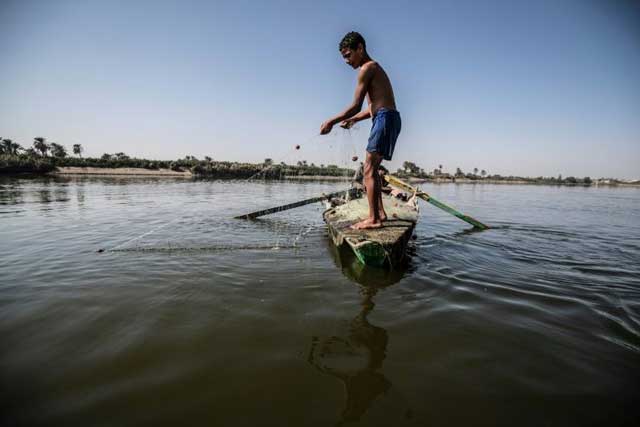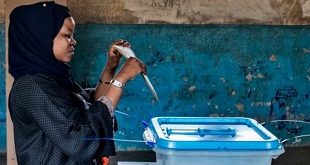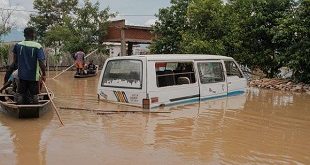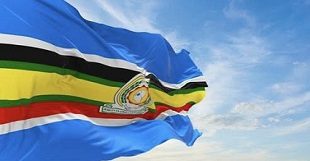
Cairo, Egypt | AFP | Under the shade of a tree, Mohamed Omar joined other farmers bickering over who would water their crops first as supply from the Nile to a nearby canal dwindled.
“My plot has been thirsty for days. I need the water to nourish the soil before it goes to others,” said Omar, 65, whose farm is nestled in a village on the outskirts of Egypt’s Giza.
“We are dependent on the Nile water which is especially short during summertime,” he added as he tended to his leafy vegetable crops of spinach and cabbage.
Egypt has for years been suffering from a severe water crisis that is largely blamed on population growth, and farmers try to make the most of the short supply.
But other factors include climate change drying up the Nile, and water pollution due to sewage discharge as well as industrial and municipal waste.
Mounting anxiety has gripped the already-strained farmers as the completion of Ethiopia’s gigantic dam on the Blue Nile, a key tributary of the Nile, draws nearer.
Egypt views the hydro-electric barrage as an existential threat that could severely reduce its water supply. But Ethiopia insists Egypt’s water share will not be affected.
“It will be devastation to all of us and our farmlands. How will we be able to sustain our businesses then? If we cannot support ourselves, how will the rest of the country find food?” said Ahmed, a 23-year-old farmer.
On Monday and Tuesday, Egypt was hosting two-day talks with Sudan and Ethiopia on the giant project with a January deadline for an accord looming.
“A deal has to be reached. Otherwise Egypt will be prone to insurmountable social and economic risk,” said Hani Raslan, an analyst at Al-Ahram Center for Political and Strategic Studies in Cairo.
– Water scarce –
Parched land, a fall in food production and an inability to generate electricity from Aswan’s High Dam are a few risks, he said.
“And this could eventually translate to political crisis and instability,” said Raslan.
The Nile provides nearly 97 percent of Egypt’s freshwater needs and its banks are home to some 95 percent of Egypt’s 100 million population, according to the United Nations.
Even historians believe the country’s ancient civilisation would not have existed if it was not for the Nile which was worshipped by the pharaohs.
The river — the world’s longest — is a lifeline supplying both water and electricity to the 10 countries it traverses.
Its main tributaries, the White and Blue Niles, converge in the Sudanese capital Khartoum before flowing north through Egypt to drain into the Mediterranean Sea
“Egypt’s dependency on the Nile does not compare with other Nile-basin countries,” said former irrigation minister Mohamed Nasr al-Din.
“We are far below water scarcity baseline,” he said.
Hydrologists note that people are facing water scarcity when the supply drops below 1,000 cubic metres per person annually.
Egyptian officials say in 2018 the individual share reached 570 cubic metres and is expected to further drop to 500 cubic metres by 2025.
In recent years, the government under President Abdel Fattah al-Sisi has been pushing for strict water conservation measures.
Those include installing water-saving taps at public facilities, recycling water and restricting cultivation of water intensive crops like rice.
– ‘US pressure’ –
Egypt also signed multi-million dollar contracts with US-based Fluence Corp to build seawater desalination plants, according to the company.
Ethiopia launched construction of its dam in 2011 and expects to begin generating power by the end of 2020 and to be fully operational by 2022.
Nine years of negotiations between the three countries have so far brought no deal.
Last month, Egypt, Sudan and Ethiopia agreed in Washington to hold a series of meetings to resolve the main points of contention regarding the filling and operation of the dam.
The three-way meetings — attended by World Bank and US observers — have set January 15 as a target to resolve the longstanding issue.
“The intensified schedule and the presence of observers increases the likelihood of all sides reaching a compromise agreement on the filling and operation of GERD,” said William Davison, senior analyst at Crisis Group.
Ethiopia says its $4 billion structure is indispensable for economic development and providing electricity.
And for Sudan the dam would provide electricity and help regulate floods every rainy season.
A breakdown in talks in October pushed Egypt to urge international mediation.
Despite increased tensions, analysts have dismissed the possibility of armed conflict.
It is “highly unlikely as it would be enormously damaging for all sides,” said Davison.
But the possibility stands “that the US government applies pressure on the parties to reach an agreement,” he added.
 The Independent Uganda: You get the Truth we Pay the Price
The Independent Uganda: You get the Truth we Pay the Price


